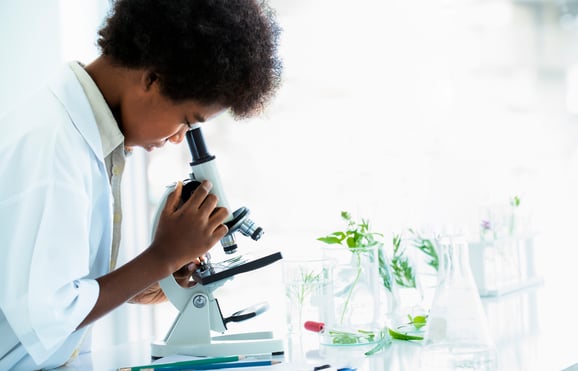
5 Easy Math Engagement Strategies for the Classroom
The news headlines are daunting. Math scores are down. School districts are scrambling to turn things around. And...
ALI Staff | Published February 15, 2017
One of the great challenges of teaching is ensuring that all students absorb the content rather than just a portion of students.
With so many different personalities, learning styles, and perspectives, it can be difficult for educators to do so effectively. One way to tackle this challenge is by implementing useful strategies, like using real-world connections.
When connecting the classroom to the real world, every student can master the content standards they are being taught.

A real-world connection is an academic technique that supports student learning gains by incorporating real-world examples.
This exciting and practical way of teaching can be applied to classrooms of all types in many different ways to give students a well-rounded approach that supports learning connections.
This academic strategy aligns with pedagogy and is one of the most successful ways of teaching content to students.
Connecting the real world to content standards is beneficial for both students and teachers because it fosters a natural learning environment.
A smooth student-teacher dynamic is mandatory for the flow in any classroom.
If content material is taught in a boring and “one way fits all” manner, students can quickly become disinterested and detached while teachers become burnt out and frustrated.
So, how do we bridge this gap?
When real-world learning techniques are applied, students can see that the information they learn is practical, applicable, and relevant to their lives.
This benefits students and provides a deeper understanding and comprehension of topic(s). This also helps students' social and emotional learning, which is just as important.
Of course, it is important for students to learn material for tests and exams, but it also benefits them to prepare for the rapidly changing world they live in and contribute to.
Involving students in a real-world way helps build up confidence, refine problem-solving skills, and foster a sense of belonging that goes far beyond the classroom.
Even if a student may dislike the subject they are being taught, they can still see the value in connecting real-world examples to it.
This natural engagement is simply applied and highly effective.
Through activities of collaboration, modeling, and creativity, students learn effortlessly and in a superior way when using real-world examples in the classroom.
Bringing real-world connections into learning does not have to be a daunting or complicated task.
It can be successfully done with simple, useful tactics that just make sense.
Students can quickly feel overwhelmed when learning complex material in both core and elective courses.
When real-world situations are paralleled to content standards, students naturally engage with what they are learning.
Educators can bring real-world connections into learning through creative examples of real-world scenarios.
This comfortable and useful teaching style helps students see the practical value of what they learn, contributing to a well-rounded education overall.
Even though real-world learning was not always the norm in classrooms, it continues to grow in popularity due to its promising results for student-teacher success.
What’s even better is that this is a general technique that can be applied to learning in many contexts.
Incorporating real-world examples into the classroom can be simple or elaborate.
These activities can be conversational, kinesthetic, individual, collaborative, and more.
There are so many real-world examples that can be used in all types of classrooms, and creativity is encouraged.
One example is by using everyday objects, such as a pencil when teaching the Law of Gravity in science class. An educator could drop a pencil on the floor and ask students, “Why did this happen?”
This simple action helps students realize that they already interact with gravity in their everyday lives.
This method is much quicker and more effective than long lectures and dry note-taking.
Other ways of presenting real-world connections include but are not limited to, using examples and case studies, bringing in guest speakers, taking field trips, integrating technology, having student-led activities, and so much more.
These activities can be paper-based or digital.
For students to retain knowledge so they can build upon what they know, teachers should use relevant examples and modify them when needed to assist the needs of all students.
These activities should use creative collaboration, modeling by the teacher, constant exploration of the real world, and more to support deeper levels of understanding for students.
It is important to bring in relevant topics that are easily modifiable so that all students feel a connection to what is being taught.
Classroom-specific creativity is highly encouraged when incorporating these real-world techniques!
The goal of establishing real-world connections is to foster deeper understanding, engagement, and retention of knowledge.
When students connect real life with classroom content, it helps them authentically engage and gain knowledge.
It can also be an enjoyable way of learning!
When this strategy is implemented correctly, students can consciously learn instead of focusing on stressful memorization, due dates, and exam scores.
It is also a progressive yet simple way for educators to elevate lesson plans.
Students become motivated and enthusiastic about their studies when they see the practical significance of what they're learning.
This also helps bridge the gap between academic learning and real-life applications, better-preparing students for success beyond the classroom.
This academic strategy continues to be important in the classroom because the goals of students and teachers are both met when using the practical and creative ways of the real world.

The news headlines are daunting. Math scores are down. School districts are scrambling to turn things around. And...

Math assessment in California is changing. What used to be a compliance exercise or reporting tool is now becoming a...

You know the moment: a student’s eyes light up when the science experiment fizzes or the math puzzle helps them...